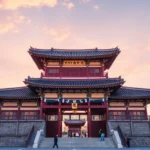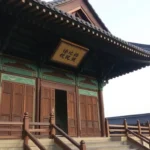Visiting the Korean Demilitarized Zone: DMZ Tour Guide

Visiting the Demilitarized Zone (DMZ) in Korea is an experience like no other. It offers a rare glimpse into one of the world's most fortified borders and a deep dive into the historical and geopolitical complexities of the Korean Peninsula. If you’re considering this unique tour, you’re in for a mix of emotions—from awe to reflection. Here’s everything you need to know to make the most of your visit.
Understanding the Historical Context: The Cold War and the Creation of the DMZ
The end of World War II in 1945 marked a pivotal moment for Korea, which had been under Japanese occupation since 1910. Instead of liberation leading to prosperity, it thrust the country into a geopolitical tug-of-war between two superpowers: the Soviet Union and the United States. This rivalry culminated in the division of Korea at the 38th parallel, a decision made hastily and without consideration for the Korean people.
As tensions mounted, the Korean War erupted in 1950, resulting in devastating losses on both sides. By 1953, an armistice was signed, establishing the DMZ—a no-man's land measuring approximately 4 kilometers wide, stretching 238 kilometers across the peninsula. The DMZ remains a symbol of the unresolved conflict and serves as a stark reminder of the pain inflicted on families separated by this border.
Many families were torn apart, with loved ones on either side of the divide, unable to reunite. This emotional toll resonates through the stories of those affected by the war, emphasizing that the consequences of political decisions often extend far beyond the battlefield.
The DMZ, created as a zone of peace, ironically became one of the most militarized borders in the world, with both North and South Korea maintaining a heavy military presence. Visitors to the DMZ can observe this tense standoff, but the experience is much more than just witnessing military might; it’s about understanding the profound human impacts of this ongoing conflict.
What to Expect from the DMZ Tour: Highlights and Stops
The DMZ tour typically lasts half a day and begins in Seoul, covering about 65 kilometers to reach the border. As you travel, an experienced guide will share insights into the historical backdrop of the Korean War and the current state of affairs between the two Koreas, who are technically still at war.
The first stop is often the DMZ Visitor Center in Paju, where you can grab a bite and immerse yourself in the atmosphere before the tour begins. Here, visitors can find a café offering local snacks while waiting for their group’s turn to proceed.
Once the formalities are sorted, the tour includes several significant sites:
- Imjingak Park: A poignant reminder of the war's human cost, this park contains memorials dedicated to the lives disrupted by the conflict. It serves as a place of hope for reunification, adorned with decorations that symbolize the longing for peace.
- Third Infiltration Tunnel: Discovered in 1978, this tunnel was one of several dug by North Korea to facilitate surprise attacks on the South. Visitors can walk through a section of the tunnel, which offers a chilling glimpse into the clandestine military strategies employed during the war.
- Dorasan Observatory: From this viewpoint, tourists can use binoculars to glimpse into North Korea, observing the so-called Propaganda Village of Kijongdong. This area raises questions about the realities of life in North Korea versus the curated image presented to the world.
- Joint Security Area (JSA): While this area is not always included in standard tours, it’s a critical site where North and South Korean soldiers stand face-to-face. Special tours can be arranged for an additional fee, providing an eye-opening experience.
How to Book the DMZ Tour
Due to the nature of the area, visiting the DMZ independently is not permitted, making guided tours the only viable option. Given the popularity of these tours and the limited spaces available, it’s advisable to book well in advance.
While you can find local agencies in tourist areas of Seoul, many travelers prefer to compare options online for convenience. A reliable choice is the DMZ tour offered by Civitatis, which includes hotel pickup, transportation, and a knowledgeable guide.
While you might find cheaper options, ensure the package includes key features like hotel pickup, as some agencies may offer lower prices without this crucial service.
Essential Tips for Visiting the DMZ
Before you embark on this journey, consider the following recommendations to enhance your experience:
- The DMZ is a highly militarized zone, meaning photography is restricted in certain areas. Always follow the guide’s instructions to ensure your safety.
- The primary language of the tour is English. If you have limited proficiency in the language, take some time to familiarize yourself with the history and context beforehand.
- Food and snack options are available at several stops, so you won’t go hungry during the tour.
- To dive deeper into the history of the Korean conflict, consider reading "Hierba" by Keum Suk Gendry-Kim.
- Don't forget to bring your passport. A physical copy is essential for entry; photocopies are not accepted.
Is the DMZ Tour Worth It?
Whether the DMZ tour is worthwhile depends largely on your interest in history and current affairs. For those fascinated by the complexities of the Korean conflict and eager to explore a unique, charged atmosphere, the tour is undoubtedly enriching.
However, if your time in Seoul is limited, you may want to weigh this experience against other activities that offer a more traditional sense of enjoyment. Reflect on your motivations: are you seeking to understand a pivotal moment in history, or are you looking for leisure?
That said, many who participate in the tour find it impactful, providing insights that linger long after the day is over. It’s not just about sightseeing; it’s an opportunity for reflection and understanding.
Ultimately, if you’re curious about Korea’s past and present, this tour offers an invaluable lens through which to view the ongoing narrative of the Korean Peninsula.
For a visual insight into the DMZ experience, check out this informative video:
We hope this guide clarifies everything you need to know before visiting the DMZ. If you decide to take the plunge, prepare for a day filled with reflection, insight, and perhaps some unexpected emotions. Enjoy your journey into one of the most complex regions in the world.
| Save on Your Trip |
| Compare and find cheap flights here |
| Discover accommodation at the best prices here |
| Book activities and excursions in Spanish here |
| Get a 5% discount on your IATI travel insurance here |
| Reserve airport transfers here |
| Find out how to withdraw money without commissions here |
| Get a 5% discount on your Holafly eSIM here |
| Rent a car with the best deals here |
| Check out the best books and travel guides here |
| Explore all our articles on South Korea |




Deja una respuesta